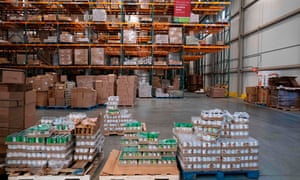Report obtained by Guardian projects acute demand and supply problem, meaning agencies will struggle to provide for the hungry
- Coronavirus – live US updates
- Live global updates
- See all our coronavirus coverage

Photograph: Alex Edelman/AFP via Getty Images
Agencies and organisations tasked with feeding children, the poor and the elderly in Washington state during the coronavirus crisis will experience shortages of food and supplies as early as mid-April, according to state government emergency planning documents obtained by the Guardian.
A 27 March situation report (SitRep) document produced by the Unified Command of Washington’s State Emergency Operations Center (SEOC) projects that a combination of acute demand at food banks and schools, supply problems for food and cleaning supplies, plus staffing shortages, will mean government and NGOs will struggle to provide for hungry people whose incomes have disappeared as the state’s economy stutters.
This raises the prospect of food bank shortages in Washington but also nationwide, as food banks across the US are being increasingly utilized by unprecedented numbers of people in an economy that has been abruptly slowed to fight the spreading pandemic.
Washington state has experienced one of the earliest and most serious outbreaks of Covid-19 in the US. Governor Jay Inslee has received praise in recent days for his decisive response, which is thought to have prevented an even worse crisis.
But the document suggests that at the predicted peak of the epidemic, which has already infected at least 4,896 Washingtonians and killed at least 195, the state will need to head off a parallel humanitarian crisis.
The SitRep document, produced by the emergency agency coordinated by Washington state’s military department and distributed to state and local agencies involved in the emergency response, details emerging problems and frantic efforts to solve them across a range of numbered emergency support functions (ESF), including communications, firefighting, and energy.
Under the heading “ESF11 Agriculture and Natural Resources”, the SitRep details the growing problems in food security. Many of the problems involve food banks – non-governmental organizations that deliver food to needy people.
The document says there is already a “shortage of food at food banks”, which is projected to become worse. It says: “NGOs have food on hand. However, burn rate is increasing fast. Demand is growing dramatically so supply is quickly being used up.”
It goes on to warn: “Food banks expect a significant gap in the food supply across the whole system by mid-April (April 10-20).”
It then offers insight into spiking demand at specific NGOs delivering food in Washington: “Northwest Harvest (a statewide food bank service) reported they are distributing 450,000lbs of food this week.”
It continues: “The burn rate and demand are rising sharply. These NGOs are seeing 30 percent to 100% increases in the number of people served.”
In a telephone conversation, Northwest Harvest chief executive Thomas Reynolds said of his food banks: “We don’t predict peak demand for another three weeks and then we anticipate peak demand for 12 to 20 weeks.”
He added: “I worked for 15 years for Care International. So what it reminds me of is earthquakes in Nepal, the tsunami in Japan, food crises in Yemen. And the difference is there’s a lot more experience in a place like Nepal or Yemen to respond to emergencies.”
The document says rural counties are already moving to rationalize food delivery in the face of demand.
“Chelan county is moving away from using small distribution centers. Instead they are going to start using a single, mass-distribution site for emergency food,” it says.
It continues with a prediction: “It’s a model we will likely see more of in the days and weeks to come.”
On Wednesday, Inslee, announced he had mobilized 130 National Guard members to provide support for food banks in Chelan and four other counties, with potentially more to follow.
The problems are being compounded by supply problems in other goods necessary for food service, such as supplies used to clean kitchens.
As in other states, Washington has closed schools, but many districts have maintained school lunch delivery as a way of feeding needy children.
These programs, too, are under strain, according to the SitRep.
One issue is in the workforce, which “is a growing issue because schools rely on older people to work in food service and as bus drivers. These are two job categories important to food assistance.”
The document says “older workers are opting not to work because of Covid concerns” and that schools are also experiencing supply problems.
The document does offer some hope that solutions to shortages are emerging, but leaves open the question of whether they will arrive in time.
Chris McGann, a spokesman for the Washington state department of agriculture, said in an email: “The current situation with its rapidly increasing demand and limited resources is putting incredible strain on the social safety net. Hunger relief is no different.”
He added: “We have called on the federal government and private industry to identify and commit additional resources to help us make sure families have the nutritional support they need to make it through this crisis.”
He also said that the problem was so far confined to food banks. “The food supply chain is otherwise operational and functional. People will still be able to get food at the grocery store.”
Reynolds stressed that Northwest Harvest was working well with the state and has “good relationship with our local elected officials”. But he said he hoped food security will become more central to political debate.
“I think we should be asking people who are running for office. What is your food policy?”



